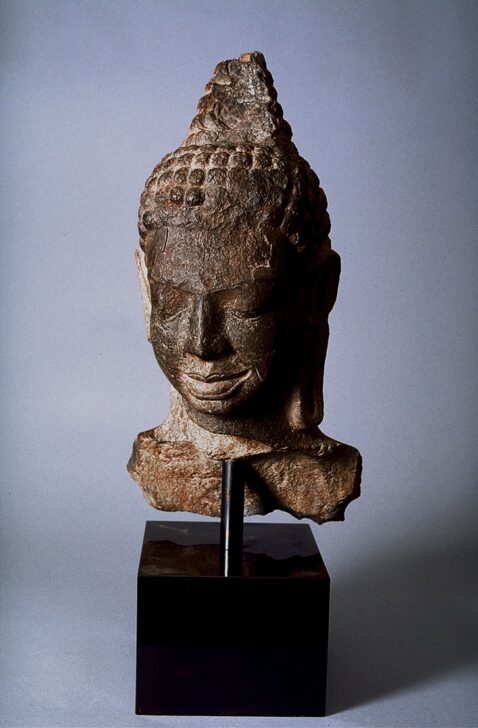Head of a Buddha (Mon-Dvaravati style)
Dvaravati Mon

Description
Head of a Buddha
(Mon-Dvaravati style)
Thailand, Dvaravati Mon
700–899
Gray limestone
Gift of John Adams Thierry in
Memory of Louis Sidney Thierry,
1993/2.35
The early kingdom of Dvaravati, which ruled central Thailand
from roughly the sixth to the eleventh century, adopted
Buddhism in the middle of the seventh century. Textual
instructions and models from India originally delineated how
Buddhas should be depicted, but this head reflects Dvaravati
ideals of perfected beauty: a slight smile and curvilinear
lips; a molded, uninterrupted eyebrow ridge; and high, wide
cheekbones. These features are joined by Indian symbols, such
as the protuberance atop the head signifying expanded wisdom
(ushnisha) and the curls that miraculously resulted when
Siddhartha, the Buddha-to-be, cut off his long hair.
Winter 2024 Gallery Rotation
____________________
March 28 2009
The early kingdom of Dvaravati, which ruled central Thailand from roughly the sixth to the eleventh centuries, adopted Buddhism in the middle of the seventhth century. Textual instructions and models, originally from India, delineated how Buddhas should be depicted, but this face’s slight smile and curvilinear lips; molded, uninterrupted eyebrow ridge; and high, wide cheekbones reflect Dvaravati ideals of perfected beauty. These features are joined by Indian symbols, such as the protuberance atop the head signifying expanded wisdom (ushnisha) and the curls that miraculously resulted when Siddhartha, the Buddha-to-be, cut off his long hair.
(Label for UMMA Buddhist Gallery Opening Rotation, March 2009)
Subject Matter:
Shakyamuni Buddha (head only)
____________________
The early kingdom of Dvaravati, which ruled central Thailand from roughly the sixth to the eleventh century, adopted Buddhism in the middle of the seventh century. Textual instructions and models from India originally delineated how Buddhas should be depicted, but this head reflects Dvaravati ideals of perfected beauty: a slight smile and curvilinear lips; a molded, uninterrupted eyebrow ridge; and high, wide cheekbones. These features are joined by Indian symbols, such as the protuberance atop the head signifying expanded wisdom (ushnisha) and the curls that miraculously resulted when Siddhartha, the Buddha-to-be, cut off his long hair.
Physical Description:
Buddha head carved from grey limestone with serene expression, elongated earlobes and ushnisha, a proturbance on the top of his head indicating his expanded wisdom.
Usage Rights:
If you are interested in using an image for a publication, please visit https://umma.umich.edu/request-image/ for more information and to fill out the online Image Rights and Reproductions Request Form.